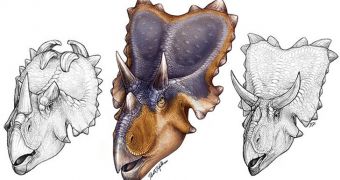A recent paper in the journal Naturwissenschaften documents the discovery of a previously unknown dinosaur species that is now referred to by the scientific community as Mercuriceratops gemini.
The new dinosaur species, an image of which is available above, is estimated to have walked the Earth about 77 million years ago, during the Late Cretaceous Period.
As detailed in the journal Naturwissenschaften, these ancient creatures could grow to measure as much as 6 meters (nearly 19.7 feet) in length. In terms of weight, it is estimated that they tipped the scale at about 2 tons, maybe more.
Impressive size aside, what makes this newly discovered dinosaur species stand out is the fact that, as shown in the image above, they sported a rather peculiar headgear, researchers explain in their paper.
More precisely, they walked around carrying an ornamentation that scientists say reminds them of the helmet of Roman god Mercury. Hence their decision to name the species Mercuriceratops gemini.
With the help of fossilized remains discovered in Montana, US, and Alberta, Canada, it has been established that these dinosaurs also had two long brow horns that grew just above their eyes, and a beak not all that different to modern parrots.
“Mercuriceratops took a unique evolutionary path that shaped the large frill on the back of its skull into protruding wings like the decorative fins on classic 1950s cars. It definitively would have stood out from the herd during the Late Cretaceous,” says Dr. Michael Ryan.
The researcher, who now works with The Cleveland Museum of Natural History in the United States, further details that, according to evidence at hand, these dinosaurs relied on their headgear not only to fight off potential enemies, but also to find romance.
“Horned dinosaurs in North America used their elaborate skull ornamentation to identify each other and to attract mates. The wing-like protrusions on the sides of its frill may have offered male Mercuriceratops a competitive advantage in attracting mates,” Dr. Michael Ryan argues.
What's interesting is that, despite their scary looks, these dinosaurs were not carnivores. On the contrary, Dr. Michael Ryan and his colleagues say that they were herbivores, meaning that they solely ate leaves, maybe various types of plants that they chanced to come by.
The scientific community – and especially paleontologists – are no strangers to dinosaurs carrying odd protrusions and appendages on their head. However, Dr. Michael Ryan says that, of all the headgears he has until now had the chance to analyze, Mercuriceratops gemini's is the most impressive.
As study co-author Dr. David Evans puts it, “The butterfly-shaped frill, or neck shield, of Mercuriceratops is unlike anything we have seen before. Mercuriceratops shows that evolution gave rise to much greater variation in horned dinosaur headgear than we had previously suspected.”

 14 DAY TRIAL //
14 DAY TRIAL //